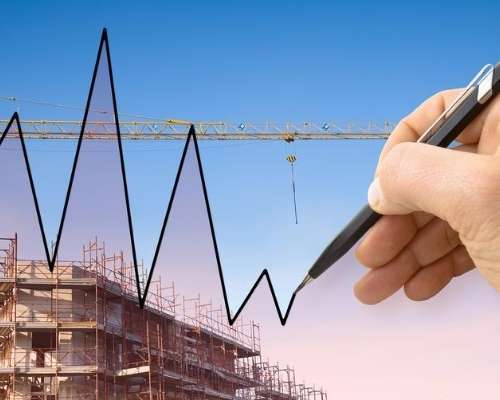6 Minute Read
June 30, 2020
0%
As we round out the fifth full month of the COVID-19 crisis, the impact is still being felt around the world. Without a clear end in sight, construction companies are focusing on shifting strategies to stay profitable and keep employees. This month’s roundup covers the state of costs for the industry, the value of digitization for mid-market companies, examples of construction companies adjusting to the current climate, how leaders should address stress amongst employees and a lofty infrastructure plan.

Coronavirus strikes the industry again. Construction Dive reported that construction costs have declined for the first time in a decade. The Turner Building Cost Index fell 1.01% between Q1 and Q2 — the first time it has reduced in value since 2010. This number is calculated using a number of factors, including labor rates, productivity, material costs and the competitiveness of the workplace. This decline has led to an increase in competition within the industry. With more companies bidding on more projects, demand for work has become the most pressing concern for construction firm leaders. “Trade contractor competition has increased in many areas as they work to secure backlog due to uncertainty they have about future opportunities,” explained Turner Vice President Attilio Rivetti. While sales may increase, profit margins are expected to be slimmer due to bidding wars. Nearly two in five contractors expect profit margins to shrink over the next six months, due to these competitive bidding wars.
The Takeaway: This is big news for the industry, but it’s not necessarily good. More competition on bidding for projects means lower prices and lower profit margins. With profit margins thinning, there’s even more reason for contractors to modernize and gain efficiencies and cost savings in other areas. They just can’t afford not to at this point.

Forconstructonpros.com shared the stories of how two construction firms handled changes due to the pandemic in their areas. When the state of Pennsylvania shut down construction projects completely, Poole Anderson Construction scrambled to address new, nebulous regulations. “We had no idea how long it was going to be, so we kept full staff for a while,” explained company president Stephanie Schmidt. “Fortunately, we had some projects in pre-construction that still required actual work being done. Eventually, we ended up laying off about 40% to 50% of our workforce. ”Luckily the company was able to bounce back quickly, securing a PPP (Payroll Protection Plan) loan and bringing those workers back. They were able to focus on a single project and evaluate safety procedures to ensure their other sites could eventually open up safely.
AA Jedson Company, LLC in New York City were lucky enough to keep half of their projects open during the shutdown. While they ended up laying off a portion of their staff, they were able to adjust to new regulations. They found PPE quickly, and strategized ways for subcontractors to distance themselves. Ultimately, the firm decided to adjust focus on earning jobs in the housing development sector and shifting from the restaurant and fitness jobs — two industries facing uncertainty in the wake of the pandemic. Like AA Jedson, Poole Anderson is open to shifting focus with future opportunities. “We are diverse enough that we work through a lot of different market sectors, so that’s helpful,” Schmidt explained. “But I think you also need to be a bit nimble and be able to look at other things that you can be doing that can help your customers and your company.”
The Takeaway: 2020 has taught all of us that things can change on a dime. Contractors should have a business continuity plan in place to protect their bottom line. As the outbreak spreads and creates new hotspots, learning from these two organizations can be invaluable for other companies that face potential shut down. This should also be another push for contractors to modernize and better position themselves to achieve business continuity and efficiencies to help protect their bottom lines while we endure this.

According to Fortune, in June, Ohio State University surveyed financial decision makers at 1,000 mid-market companies from across the United States and found that, even among falling revenues, spending cuts and disrupted operations, those companies are maintaining or even slightly accelerating their digital transformation budgets. While 57% of respondents have seen their revenue fall in recent months, 27% said they thought the pandemic would have a positive impact on their digital transformation. For these companies, digital transformation leads to operational efficiencies, cost cutting and scalability, all benefits that are highlighted during a crisis like COVID-19.It’s clear that mid-market executives see the value in going digital. Organizations are committed to making significant, long-reaching changes to how their company works and digitization will play a key role in shaping those changes.
The Takeaway: Digital transformations are the key to sustainable profitability and mid-sized businesses recognize and support that. There is no better place for these transformations than in the construction industry, where outdated processes and strung-together software systems are ripe for modernization that brings new efficiencies and boosts profitability. Contractors looking to modernize should look for a fully integrated suite of construction-specific, cloud-based solutions in order to maximize the value of their digital transformations and effectively scale operations for the future.

It’s no secret that the Coronavirus outbreak has impacted employees across the world. The impact has perhaps been felt harder in construction, where employees are the primary asset of the organization. Construction Business Owner broke down some things construction leaders should keep in mind during this tough time.
With 20% of the U.S. population having an underlying diagnosable mental health condition, the stress of COVID could bring out unanticipated anxiety. Construction leaders should do what they can to ensure the safely, and long-term health of their employees.
The Takeaway: Coronavirus is a global health issue that has impacted each one of us. Workers are the most essential part of any construction business. Have resources available and regularly communicate them with staff. Remember, we’re all in this together.

Presidential candidate Joe Biden recently outlined his plan for a nearly $2 trillion infrastructure spend, focused on renewable energy, creating jobs, improving transit systems and rebuilding crumbling infrastructure. "We need to modernize America's infrastructure," Biden said. "Here we are with an economy in crisis, but an incredible opportunity to not just build back to where we were before, but better, stronger, and more resilient." Biden sees climate change as both an existential threat and an economic opportunity. His multi-trillion dollar plan puts the focus on renewable energy and sustainable infrastructure initiatives. If passed, the plan would include building 1.5 million energy efficient homes, retrofitting four million older buildings, decarbonizing electrified homes and focus on removing hazards such as abandoned oil and gas wells near disadvantaged communities.
The Takeaway: Infrastructure planning has been an ongoing conversation with top government officials and rightfully so. This is one of the largest proposals ever presented and past plans have struggled to get passed. If passed and funded, this would keep business for all types of contractors going strong for at least the next decade — likely more.
Want more takes on news and issues permeating the construction industry? Be sure to subscribe to our blog for the latest trends and industry news, or visit viewpoint.com to learn how leading-edge technologies can help grow your construction operations.
6 Minute Read
June 30, 2020
6 Minute Read
May 28, 2020
6 Minute Read
April 30, 2020